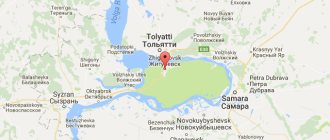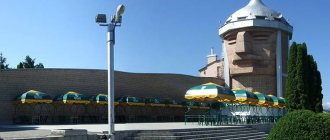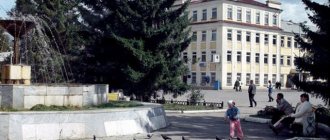Pyatigorsk is one of the oldest resort cities in the North Caucasus. It is located between the peaks of several mountains, the highest mountain being Beshtau. The area of the city is 97 km2, it rises 500 m above sea level.
The map of Pyatigorskaya from a satellite allows you to view in detail the 2nd largest city in the Stavropol Territory by number of inhabitants. About 140 thousand people live in the city itself, and another 60 thousand occupy the outskirts and nearby villages.
The Podsumok River flows along the western, northwestern and northern outskirts of the city. As can be seen on the map of Pyatigorsk by district, this winding mountain river is not the only body of water in the resort city. In the central and eastern part of Pyatigorsk there are many mineral springs, for which tourists and vacationers come to the city.
Pyatigorsk municipality consists of 7 villages. You can see the structure of the city on a map of Pyatigorsk with diagrams. The main attractions can be found in the northern and central regions of the agglomeration.
Where is Pyatigorsk?
Pyatigorsk is a resort town in the Stavropol region of Russia, which is the administrative center of the municipality of the resort town of Pyatigorsk.
It is located on the Mineralovodsk foothill plain. The city is located on the right and left banks of the Podkumok River. Within the city limits there is Mount Mashuk, whose height is 993 m above sea level. It is considered the center of the North Caucasus Federal District. The approximate population is 146 thousand people, the total area of Pyatigorsk is 97 square kilometers. The climate in Pyatigorsk is characterized by mild winters and hot summers with low relative humidity. In winter, frequent changes in atmospheric pressure are observed. The annual precipitation rate is 518 mm.
Pyatigorsk is located in the same time zone as Moscow, the offset relative to Coordinated Universal Time (UTC) is +3.
What to try
Gastronomic establishments in Pyatigorsk offer a colorful mix of dishes from national cuisines - Ossetian pies, Russian pancakes, Karachay “khychin” and Greek “gyros”. However, there is one dish that can be found in almost every establishment - shish kebab. Here it is made from everything - meat, fish, vegetables and even fruits. It’s worth trying its fruity version at least once - juicy pineapple slices are layered with pieces of fat tail fat and fried on the grill. It is better to order dishes of Caucasian cuisine not in pretentious restaurants, but in small national eateries - where the locals themselves eat. Almost all vacationers take away memories of Pyatigorsk ice cream from the resort. The local cold storage plant makes it from natural ingredients of “Soviet” quality - you can taste real ice cream and popsicle only here.
Pyatigorsk Airport
Pyatigorsk does not have its own airport. The nearest airfield is in the city of Mineralnye Vody. The distance from the center of Pyatigorsk to the airport is 23 km. The airport has the status of a federal facility and is the largest airfield in the Stavropol Territory and the North Caucasus Federal District. Airfield type: civil. Operating hours: 24 hours a day.
The airport provides servicing for aircraft of major Russian airlines: Pobeda, Aeroflot, UTair, Yakutia, and Ural Airlines. Popular destinations of regular and charter flights: Moscow, Rostov-on-Don, Yekaterinburg, Chelyabinsk. Annual passenger traffic is more than 2.4 million people.
What to bring
As a souvenir of your spa treatment, you can bring a branded mug - a special sippy cup with a spout from which you drink mineral water. Such spa dishes are sold in souvenir shops and drinking galleries. It costs from 100 RUB. As for the healing water itself as a souvenir, it is unlikely that you will be able to give it to your loved ones at home. Water collected from mineral springs is not intended for storage. After just a few hours in the bottle, it begins to deteriorate - it becomes cloudy and a sediment appears.
A good healing gift would be soap with the addition of Tambukan mud. It is made by hand, decorating the outer surface with an image of one of the resort attractions, so it has a completely souvenir look. Such healing perfumes cost about 200 RUB. On the outskirts of Pyatigorsk there is a network of the largest clothing markets in the North Caucasus, where you can buy clothes, shoes, electronics and household goods at lower prices. Fur products produced at the local factory and hand-knitted woolen items are especially famous.
- Where can a tourist go shopping in Pyatigorsk?
Automobile highways
The following roads pass through Pyatigorsk:
- P217 “Caucasus” is a highway with a length of 1118 km. It is part of two European routes E50 and E119. Passes through the territory of the Krasnodar Territory, Chechnya, Dagestan, Stavropol Territory, North Ossetia, Kabardino-Balkaria. The final point of the route is the state border with Azerbaijan. The road surface of route R-217 is asphalt.
- A157 is a federal highway, the length of which is 134 km. The road surface is asphalt. The route passes Essentuki, Kislovodsk, Pyatigorsk.
- A165 is a federal highway with a total length of 79 km. The route passes through Pyatigorsk, Essentuki and Cherkessk. The road surface is asphalt.
- E50 is a European route that passes through the territory of the Czech Republic, Germany, France, Russia, Ukraine, and Slovakia. The total length of the highway is 6,000 km.
Infrastructure
Pyatigorsk is a multidisciplinary resort center of the country with developed infrastructure. The city has a large number of shops, boutiques, shopping centers, markets, and light industry enterprises. There are also many cafes, restaurants, and entertainment centers for vacationers. But most of all, those who come here remember the well-maintained parks and alleys.
The resort infrastructure includes sanatoriums and hotels of various levels, from economy to VIP class. The list of sanatoriums can be found here.
The city's transport system is quite developed and consists of: route public transport, tram lines, and numerous taxi services.
What’s interesting is that in the city, famous for its mineral springs, there is almost a shortage of fresh water. The surroundings of the resort are crossed by two stormy shallow rivers - Kuma and Podkumok, which, although very beautiful and attractive in appearance, but, unfortunately, do not fully cover the city's need for drinking water. Therefore, Kuban compensates for the lack of drinking water in Pyatigorsk.
At the same time, the water is very tasty and you don’t even need to use drinking filters.
The natural reservoirs located in the vicinity of the resort are the Tambukan and Lysogorsk lakes, they have impressive reserves of healing mud, while the water in them is bitter-salty, similar to sea water, although it has a specific smell, but swimming in these lakes is very useful, you can immediately and take mud baths yourself, which is very popular among city guests and local residents too.
There is also a fresh artificial lake in Pyatigorsk. Here you can afford the luxury of calmly swimming in fresh water, and fishing enthusiasts can sit over a fishing rod - this is Novopyatigorsk Lake located in the southwestern part of the city.
The lake is clean and the surrounding area is very picturesque. Weeping willows are beautifully located along the shores of the lake, which allows you to spend a very long time in nature without the risk of getting sunburned, since you can always hide in the shade of these beautiful trees.
What is the city of Pyatigorsk famous for?
- In Pyatigorsk there is a sculpture of an eagle - a symbol of the region, which is located on the top of Hot Mountain. The eagle was installed in 1901, but was destroyed twice in the 20th century.
- On Mount Mashuk there is a gazebo “Aeolian Harp”, which is made in the form of a classic rotunda with a dome-shaped roof. The gazebo offers a picturesque panoramic view of the outskirts of Pyatigorsk. The structure itself is installed on the edge of a cliff. A paved path leads to the gazebo. “Aeolian Harp” is especially noteworthy because M. Yu. Lermontov visited here several times.
- On the territory of the city there is a monument to Lermontov, who lived here during his exile and died from N. S. Martynov’s bullet. The monument was erected in 1889 and is a sculpture of Lermontov, who sits on a pedestal in the shape of a rock.
- In the central part of Pyatigorsk there is the Lermontov Gallery - a structure made of glass and steel. The gallery was brought from the Nizhny Novgorod exhibition at the end of the 19th century. Today the gallery building houses a concert and exhibition complex.
- In 1939, the Stavropol Operetta Theater opened in the city. The author of the project is A.I. Kuznetsov. Previously, the building was known as the People's House.
- One of the main Lermontov places in Pyatigorsk is the M. Yu. Lermontov Museum-Reserve. The building was built in the first half of the 19th century. Here the writer spent his last years of his life. The museum itself was founded in 1912.
- On the slope of Hot Mountain there is an artificial cave, Diana’s Grotto, which was created in the 1930s in honor of the first ascent of Elbrus. The Bernardazzi brothers were involved in the design of the structure. The grotto got its name in honor of the goddess Diana.
- The decoration of Cathedral Square is the “Fairy Tale” fountain - a sculpture that represents a fairy-tale mountain with grottoes. Jets of water gush around the fountain, enveloping the stone sculptures in a mist.
- A cable car leads to the top of Mount Mashuka. The length of the path is 1 km. The road was built in the 1970s. The cable car cars offer a magnificent view of the mountain range that surrounds Pyatigorsk.
Five mountains
Noon, 21st century. The outskirts of Pyatigorsk are still picturesque Photo from the site fbr.su
The history of the area called “Five Mountains” is quite ancient. The Arab traveler Ibn Batuta wrote to the Golden Horde Khan in 1334: “Then I went to the Sultan’s camp, which was then in a place called Besh Dag (Five Mountains) and soon reached his horde, or camp, on the first of Ramadan. There we saw a whole moving city, with streets, houses, mosques and kitchens; by order of Sultan Muhammed, everything instantly stops at the place where he orders. Sultan Uzbek is very powerful, has great power and is terrible for infidels. He is one of the seven great kings in the world, who are: the Sultan of the West, the Sultan of Egypt and Syria, the Sultan of both Iraqs, the Sultan of the Turks, the Uzbek, the Sultan of Turkistan and Mawara el-Nagar, the Sultan of India and the Sultan of China.”
But even earlier, in 1282, the Tatar Baskak of the Kursk reign settled a certain “Cossack settlement” with Cherkasy from Pyatigorye. Archaeologists operate with facts from the 3rd millennium BC.
However, it was still a long way to the resort. Much water has flowed from mineral springs, they have been mentioned many times - but without indicating their healing properties. “And below the Kurpa River, 20 versts, a hot well fell into the Terek on the right side. And below the Baksan River is the Palk River 20 versts; and those 4 rivers all converged into one place and that’s why one river, the Belaya, flowed, and along those rivers the land of the Pyatigorsk Cherkasy, a hot well.”
Only in 1793, academician Peter Simon Pallas compiled the first scientific description of the healing waters of Goryachaya Gora (the city was then called Goryachegorsk). And in 1803, an official statement by a group of specialists appeared: “The healing waters of the Caucasus are not inferior in their benefits to some of the best foreign ones, and some are superior.” And Tsar Alexander the First officially declares Goryachegorsk a resort city.
Traveling with children
Interesting places to visit with children are:
- an operetta theater where children's musical fairy tales are regularly shown;
- parks named after Kirov and on the territory of the entertainment and restaurant complex “Park Rodnik”, where there are zoos, including contact ones;
- Terek stud farm, which invites little tourists on excursions and horse riding;
- the anti-cafe “Divan” and the educational toy store “Rebus”, where toy libraries are periodically held;
- Insect Museum in the Academic Gallery, where you can get acquainted with the collection of tropical and Caucasian insects. In addition to an impressive collection of dry exhibits, live insects are presented to the attention of tourists: spiders, scorpions, cockroaches, stick insects and tropical beetles. In addition, chameleons, lizards, frogs and snakes live here.
You can go to the operetta theater in Pyatigorsk with children: musical fairy tales are often staged there
Traveling at different times of the year
Pyatigorsk has a temperate continental climate. Summers here are warm and winters are relatively mild. Many resorts in the city are open year-round. However, experts recommend going for health treatments from April to October. The most comfortable time for educational tourism is the second half of spring, summer and early autumn. During this period it is convenient to climb mountains. It can rain frequently in early spring, which can cause inconvenience. From mid-April the air warms up to +15. Summer in Pyatigorsk is warm, sunny and without precipitation. The air temperature in July can reach +30. In November there are frosts and it may even snow. In winter there is a lot of snow, and the temperature usually stays between -5–6 degrees.
In early autumn, Pyatigorsk is especially beautiful








